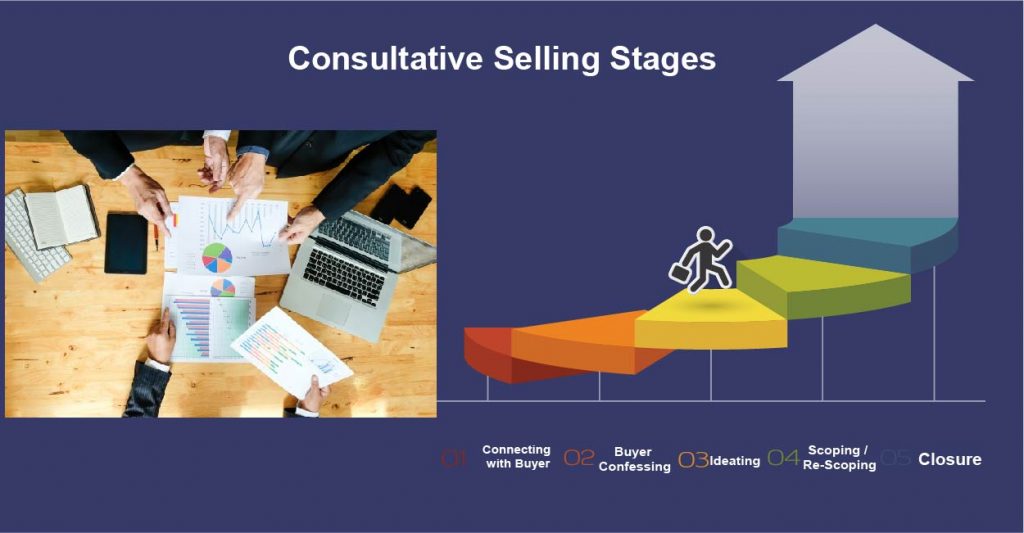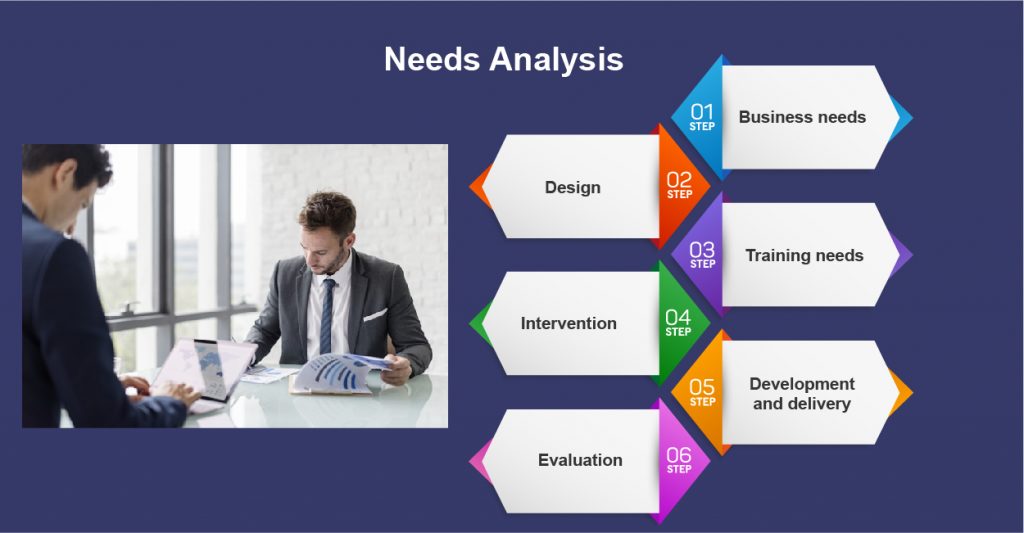Consultative Selling
Consultative Selling
Benefits of Consultative Selling
Converts many Nos into conversations
Makes the prospect understand the solution
Price becomes less important
Makes the prospect understand the pain point
Focus more on creating value
Our Process
Consultative selling is a sales approach that prioritizes relationships and open dialogue to identify and provide solutions to a customer’s needs. It is hyper focused on the customer, rather than the product being sold. … Consultative selling skills help sales professionals position differentiated, compelling solutions.
Converts many Nos into conversations
- Talk to Customers on Their Terms.
- Ask for Feedback. …
- Nurture through Conversation. …
- Don’t Just Convert, Converse.

Focus more on creating value
- Balance questions with insights.
- Build knowledge-based trust.
- Keep it conversational and genuine.
- Take ownership of the conversation.

Makes the prospect understand the pain point
- Survey Customers with the Right Questions
- Get your Sales Team Talking
- Check Out Online Reviews
- Take a Look at Your Competitors

Establish a Clear Sales Roadmap.
- Develop a sales plan template.
- Define your target market.
- Set clear goals.
- Develop a team structure

JOIN NOW
JOIN OUR WEEKLY NEWSLETTER

FAQS.
FAQS.
Consultative selling is a sales approach that prioritizes relationships and open dialogue to identify and provide solutions to a customer’s needs. It is hyper focused on the customer, rather than the product being sold.
Consultative selling is an investigative approach to sales. Rather than telling prospects what they need, you ask prospects thought-provoking questions that help them identify their own pain points
Knowing and understanding customer needs is at the centre of every successful business, whether it sells directly to individuals or other businesses. Once you have this knowledge, you can use it to persuade potential and existing customers that buying from you is in their best interests.
Offer multi-channel support, Make collecting feedback a company process, Measure customer satisfaction regularly, Ask for feedback across all touchpoints, Actively ask customers for feedback, Share feedback across all your teams, Reply to all feedback., Act on complaints and negative reviews.
Yes, asking questions is included in active listening. The questions you ask help you uncover buyer needs and desires, connect with them, and demonstrate your expertise. By asking questions, you can discover the buyer’s buying process. It also allows you to qualify the sale and ensures that you and the buyer are on the same page at any given time.
A question approachOpening a sales call with questions that will engage your prospect in a dialogue. is also an effective way to open a sales call because it shows the prospect that you are interested in listening to him, it begins a dialogue, and it helps you get the information you need to move the sale along
The three “As,” which are attitude, attention, and adjustment, play a key role in listening skills. Once you understand how these impact your listening, they most likely will stay in your mind and keep you on your toes when it comes to the times you need them the most.
Becoming an Active Listener, Pay Attention, Show That You’re Listening. Use your own body language and gestures to show that you are engaged, Provide Feedback, Defer Judgment, Respond Appropriately.
Here are 5 ways to research your potential customers.Use Google Alerts, Mention or Talkwalker Alerts, Interview current customers, Study your web analytics., Use your competitors and industry,Leverage professional social networks.
What is customer training program?
Customer training is important for every customer. It’s educating your customers on how to use your product so that they get the maximum benefit from it.
Therefore a Potential Customer is someone who is capable of becoming a purchaser of product and/or services from an organisation.By understanding your Potential Customers, those most likely to buy from your organisation, you can target your Communication Material accordingly.
Consultative selling is a needs-based selling approach that focuses on building a relationship with a customer or prospect, understanding their problems, and developing solutions to their challenges through open-ended questions and active listening.
Ask which solution the customer would like to go with, and remind them you’ll be working with them along the way. Sell a solution. Once you have a way to solve their problem, thoroughly explain how your product will solve the problem. Showcase the approach and why it works specifically for them to get their buy-in
Avoid Seller-Centric Behaviors, Shift to a Mindset of Authenticity, Lead the Conversation With A Plan, Build to Decisive Momentum, Leverage Insights Gained Through Questioning, Work Off Facts, Not Assumptions.
The main difference between solution selling and consultative selling is that solution selling at its core would focus more on selling the solution to your prospect’s problem instead of selling the product itself, while consultative selling incorporates selling the solution it tends to focus more on.
Consultative selling is a sales approach that prioritizes relationships and open dialogue to identify and provide solutions to a customer’s needs. It is hyper focused on the customer, rather than the product being sold.
Consultative selling is an investigative approach to sales. Rather than telling prospects what they need, you ask prospects thought-provoking questions that help them identify their own pain points
Knowing and understanding customer needs is at the centre of every successful business, whether it sells directly to individuals or other businesses. Once you have this knowledge, you can use it to persuade potential and existing customers that buying from you is in their best interests.
Offer multi-channel support, Make collecting feedback a company process, Measure customer satisfaction regularly, Ask for feedback across all touchpoints, Actively ask customers for feedback, Share feedback across all your teams, Reply to all feedback., Act on complaints and negative reviews.
Yes, asking questions is included in active listening. The questions you ask help you uncover buyer needs and desires, connect with them, and demonstrate your expertise. By asking questions, you can discover the buyer’s buying process. It also allows you to qualify the sale and ensures that you and the buyer are on the same page at any given time.
A question approachOpening a sales call with questions that will engage your prospect in a dialogue. is also an effective way to open a sales call because it shows the prospect that you are interested in listening to him, it begins a dialogue, and it helps you get the information you need to move the sale along
The three “As,” which are attitude, attention, and adjustment, play a key role in listening skills. Once you understand how these impact your listening, they most likely will stay in your mind and keep you on your toes when it comes to the times you need them the most.
Becoming an Active Listener, Pay Attention, Show That You’re Listening. Use your own body language and gestures to show that you are engaged, Provide Feedback, Defer Judgment, Respond Appropriately.
Here are 5 ways to research your potential customers.Use Google Alerts, Mention or Talkwalker Alerts, Interview current customers, Study your web analytics., Use your competitors and industry,Leverage professional social networks.
What is customer training program?
Customer training is important for every customer. It’s educating your customers on how to use your product so that they get the maximum benefit from it.
Therefore a Potential Customer is someone who is capable of becoming a purchaser of product and/or services from an organisation.By understanding your Potential Customers, those most likely to buy from your organisation, you can target your Communication Material accordingly.
Consultative selling is a needs-based selling approach that focuses on building a relationship with a customer or prospect, understanding their problems, and developing solutions to their challenges through open-ended questions and active listening.
Ask which solution the customer would like to go with, and remind them you’ll be working with them along the way. Sell a solution. Once you have a way to solve their problem, thoroughly explain how your product will solve the problem. Showcase the approach and why it works specifically for them to get their buy-in
Avoid Seller-Centric Behaviors, Shift to a Mindset of Authenticity, Lead the Conversation With A Plan, Build to Decisive Momentum, Leverage Insights Gained Through Questioning, Work Off Facts, Not Assumptions.
The main difference between solution selling and consultative selling is that solution selling at its core would focus more on selling the solution to your prospect’s problem instead of selling the product itself, while consultative selling incorporates selling the solution it tends to focus more on.
Blogs on Consultative Selling
Read more on blogs on Consultative Selling get more insights
Consultative Selling Stages
Buyers have a point of view and Sellers have a point of view. Buyers have pressure to buy a solution to solve a business pain point.
Needs Analysis
As a salesperson, we always take pride in giving solutions. However, many times, we have looked at giving solutions from one way – our way.


